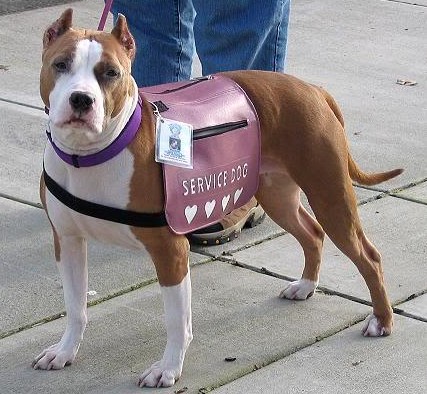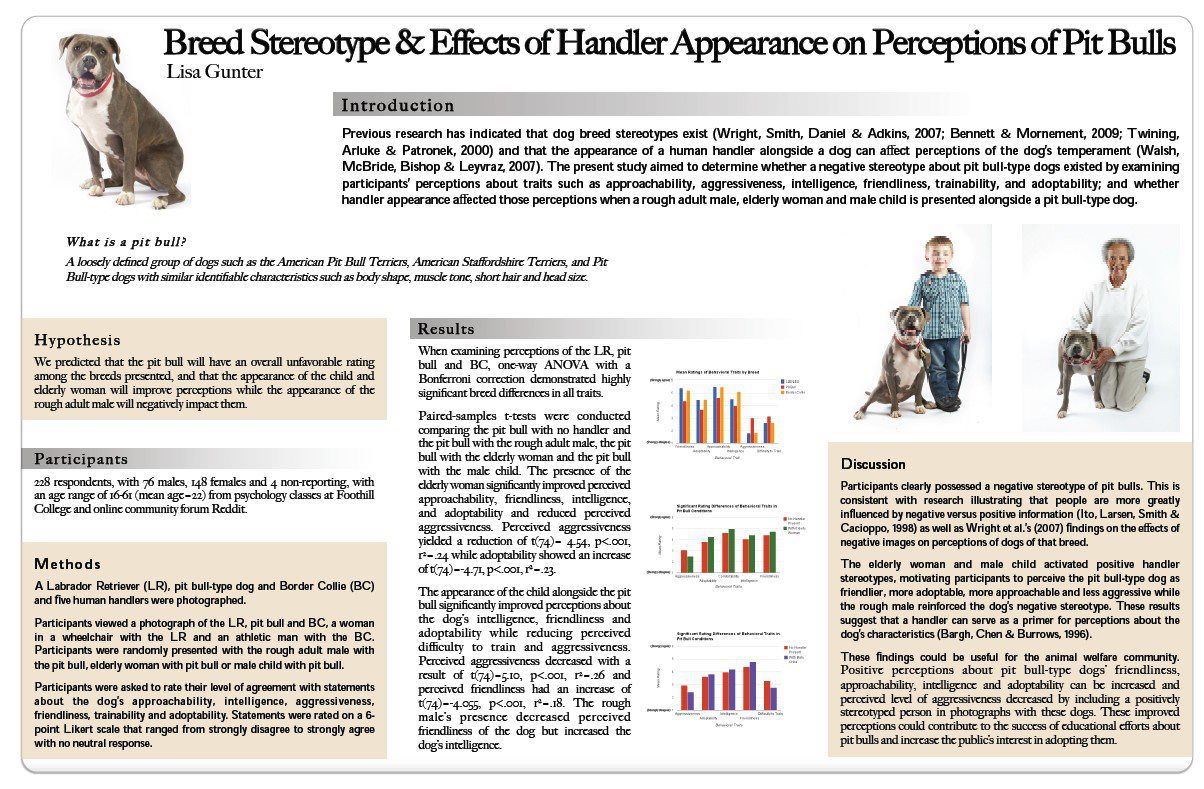
Can A Pitbull Be A Service Dog?
(Updated September 2023)
The question of “Can Pitbulls be service dogs?” comes up often in cities and counties with regressive, discriminatory Breed Specific Legislation and Breed Discrimination Legislation (BSL/BDL) laws.
With so many people parenting “Pit Bulls,” and ignoring ignorant it got me thinking about how many working “Pit Bull” service dogs there are in cities with archaic discriminatory BSL and BDL laws. For example “Pit Bulls” have been outlawed in many cities. Not even a dog trainer is legally allowed to be the parent of a “Pit Bull,” however, there are exceptions!
The reason I put quotes around “Pit Bulls” is that many people and organizations incorrectly classify this name/label as a breed. “Pit Bulls” are not a recognized dog breed. In fact, a “Pit Bull” is nothing more than a mutt with a certain “look” to it. It may be mixed with anything from a Golden Retriever to a German Shepherd (and DNA tests show that this is often the case).
Studies by behaviorists, veterinarians, and Ph.D.s have found BSL/BDL to be completely ineffective in reducing fatalities or dog bites to people in any jurisdiction, ever recorded. In the end, regressive, and ignorant legislation only costs taxpayers more money and hardship as jurisdictions try to regulate unregulatable laws.
In addition to BSL/BDL being ineffective at reducing dog bites and human fatalities from dog bites, racial/breed profiling is also fundamentally flawed at its core as Dr. Victoria Voith, professor of veterinary medicine at Western University in Pomona, California states “as many as 75% of all mixed-breed dogs may be mislabeled.” She goes on to say, “There’s so much behavioral variability within each breed, even more between breed mixes, that we cannot reliably predict a dog’s behavior or his suitability for a particular adopter based on breed.”
If board-certified veterinarian behaviorists and dog professionals can’t even accurately label a dog’s breed correctly, how can we use breed labeling as the sole measure of whether a dog lives or dies?
Notwithstanding the glaring problem of untrained officials trying to label a dog as a breed that doesn’t even exist (“Pit Bulls”).
Further, dogs within the same purebred litter are often not identical, behaviorally, or morphologically similar, so how could anyone compartmentalize all unique individuals into one category based on looks and sentence them to death? It is inhumane and ignorant on so many levels.
Because Pitbulls are mutts, and because even the most educated, dedicated professionals cannot accurately tell or label what breed a dog is, it stands to reason that the law is ineffective and useless.
What should we advocate instead is to start regulation in the pet training industry, and for dog breeders and puppy mills, but equally important requiring the licensing of pet parents before they adopt pets.
Unfortunately, ignorant journalists and the public consistently misidentify dogs that look muscular and have large heads, wide shoulders, and short hair.
Pit Bulls Service Dogs Bites
Equally important is to evaluate the parents. There is considerable evidence that “Pit Bull” parents are themselves very high-risk individuals. As per a study in the Journal of Interpersonal Violence revealed that “parents of vicious dogs were significantly more likely to have criminal convictions for aggressive crimes, drugs, alcohol, domestic violence, crimes involving children and firearms.” The author continued, “Vicious dog owners reported significantly more criminal behaviors than other dog owners,” and ranked “higher in sensation seeking and primary psychopathy.”
Research suggests that dog bites and aggressive dog behavior are linked to socioeconomic conditions. A 2011 study, in the Journal of Forensic Sciences, found that “vicious dog owners reported significantly higher criminal thinking, entitlement, sentimentality, and super-optimism tendencies. Vicious dog owners were arrested, engaged in physical fights, and used marijuana significantly more than other dog owners.” So yes, this sheds some light on the skewed bite statistics and shows a direct correlation between American Pit Bull Terrier parents and aggression.
Breed “identification” is mostly incorrect. Breed-specific or looks-specific?
Here are some more studies and interviews that show when professionals and laypeople were asked what breed a dog was they were mostly incorrect in predicting the dog breed.
Lastly, it might be helpful to understand dog bite scales, how they’re measured, and statistics.
“Pit Bull” Service Dog Legalese
After a curt response from numerous inquiries and attempts to get clarification from many animal control officers and county officials in jurisdictions that ban breeds, it turns out that if a “Pit Bull”, or anything that looks like one, is a service dog under the ADA Title II or III they are exempt from the onerous, antiquated, regressive BSL/BDL bans. This makes sense since ADA federal laws overrule state and/or local laws.
However, getting an American Pit Bull Terrier does not obliterate the responsibility and obligation of the dog parent to have an impeccably well-behaved and trained service dog. Just the opposite is true. Parents with dogs that have stigmas, have to go above and beyond normal dog training and behavior classes to set impeccable training and behavior standards to change public perception.
A good example would be to train a dog to at least the obedience and behavior level of a therapy dog and emotional support dog. However, unfortunately, therapy dogs and Emotional Support Animals (ESAs) are not allowed to be kept as pets in BSL jurisdictions. In order to keep a “Pit Bull” in BSL counties, the dog would still need to be a task-trained service dog. However, a Psychiatric Service Dog (PSD) does fall under the ADA laws that give disabled individuals rights. More importantly, rights that trump BSL/BDL laws.
CAVEAT: Only a morally bankrupt individual would ever attempt to trick people or make them believe their ill-behaved, untrained, aggressive, or ill-mannered pet is a CGC, ESA, therapy dog, or fraudulent service dog. All pet parents should strive for their dog to be extremely well-mannered and trained to at the very minimum, a CGC designation in order to become a therapy dog or ESA (or if you have a disability, a PSD).
If you are looking for a service dog to train why not save a life and make an Americal Pit Bull Terrier a service dog! It’s a win-win.
Please note, that PSDs are considered service dogs, and ESA’s are not. Your dog could be one or the other, or both. When considering living with your ESA, Housing/U.S. Department of Housing and Urban Development (HUD) and the Federal Housing Administration (FHA) laws still pertain. These are the laws you must follow, and that may disallow certain living arrangements, it is very situational and case by case so you must do your homework thoroughly or call us for a Phone/Video Consultation.
However, by and large, for citizens living in less complex housing arrangements such as single-family homes or pet-friendly buildings, having a legitimate “Pit Bull” service dog may be the ticket to saving your dog’s life!
Pitbull Service Dog Conclusion
If you’re in a county where BSL exists and are in need of a service dog, I would strongly consider training a Pit Bull service dog. When you hear someone ask, “Can a pitbull be a service dog?” you can now confidently say yes and start training your Pit Bull to be a service dog.
If I had a disability, I would most certainly speak to my health professional regarding my need for my professionally trained service dog to live with me in my home.
I would then find a Certified Dog Behavior Consultant (CDBC), and that specializes in training service dogs to task-train my dog to mitigate my disability. After I had the service dog extremely well trained (measured in months and years), I would prepare and send my dog’s resume with his dog training credentials to the owner, landlord, homeowners association (HOA), or whatever governing body oversees my living situation.
I would be sure to research the laws pertaining specifically to my living situation before contacting the housing authority.
If you are disabled, your options are now much more vast, and you have likely met the requirements to be the parent of a Pit Bull in counties that ban breeds.
There are many more pet-friendly apartments in Los Angeles and options open to you now than before when you would have been forced to move out of an ignorant count with BSL laws, or have been forced to surrender your pet to an animal shelter.
In my earlier example, given that there are only a few investigators in most counties, versus roughly millions of residents, statistically speaking you are not likely to get into an altercation with the law.
Additionally, those investigators are responsible for researching all animal violence cases on top of responding to Pit Bull allegations, and being that Pit Bull cases are admittedly “complaint-driven” the chances you will ever get bothered are Slim to none, and Slim just left town.
Nonetheless, those facts would not provide me with any solace or comfort, and I would proceed as stipulated above to save myself and my Pit Bull service dog a lot of hardship down the road and make it legal to live with my Pit Bull service dog in any county that bans breeds.



Leave a Reply